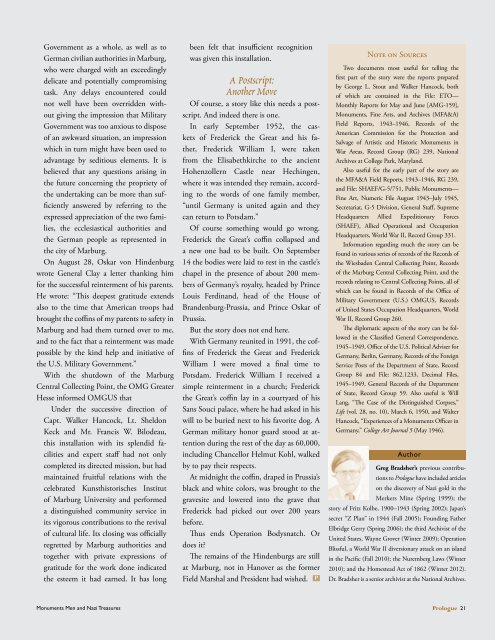monuments-men
monuments-men
monuments-men
- No tags were found...
You also want an ePaper? Increase the reach of your titles
YUMPU automatically turns print PDFs into web optimized ePapers that Google loves.
Govern<strong>men</strong>t as a whole, as well as toGerman civilian authorities in Marburg,who were charged with an exceedinglydelicate and potentially compromisingtask. Any delays encountered couldnot well have been overridden withoutgiving the impression that MilitaryGovern<strong>men</strong>t was too anxious to disposeof an awkward situation, an impressionwhich in turn might have been used toadvantage by seditious ele<strong>men</strong>ts. It isbelieved that any questions arising inthe future concerning the propriety ofthe undertaking can be more than sufficientlyanswered by referring to theexpressed appreciation of the two families,the ecclesiastical authorities andthe German people as represented inthe city of Marburg.On August 28, Oskar von Hindenburgwrote General Clay a letter thanking himfor the successful reinter<strong>men</strong>t of his parents.He wrote: “This deepest gratitude extendsalso to the time that American troops hadbrought the coffns of my parents to safety inMarburg and had them turned over to me,and to the fact that a reinter<strong>men</strong>t was madepossible by the kind help and initiative ofthe U.S. Military Govern<strong>men</strong>t.”With the shutdown of the MarburgCentral Collecting Point, the OMG GreaterHesse informed OMGUS thatUnder the successive direction ofCapt. Walker Hancock, Lt. SheldonKeck and Mr. Francis W. Bilodeau,this installation with its splendid facilitiesand expert staff had not onlycompleted its directed mission, but hadmaintained fruitful relations with thecelebrated Kunsthistorisches Institutof Marburg University and performeda distinguished community service inits vigorous contributions to the revivalof cultural life. Its closing was offciallyregretted by Marburg authorities andtogether with private expressions ofgratitude for the work done indicatedthe esteem it had earned. It has longbeen felt that insuffcient recognitionwas given this installation.A Postscript:Another MoveOf course, a story like this needs a postscript.And indeed there is one.In early September 1952, the casketsof Frederick the Great and his father,Frederick William I, were takenfrom the Elisabethkirche to the ancientHohenzollern Castle near Hechingen,where it was intended they remain, accordingto the words of one family member,“until Germany is united again and theycan return to Potsdam.”Of course something would go wrong.Frederick the Great’s coffn collapsed anda new one had to be built. On September14 the bodies were laid to rest in the castle’schapel in the presence of about 200 membersof Germany’s royalty, headed by PrinceLouis Ferdinand, head of the House ofBrandenburg-Prussia, and Prince Oskar ofPrussia.But the story does not end here.With Germany reunited in 1991, the coffinsof Frederick the Great and FrederickWilliam I were moved a final time toPotsdam. Frederick William I received asimple reinter<strong>men</strong>t in a church; Frederickthe Great’s coffn lay in a courtyard of hisSans Souci palace, where he had asked in hiswill to be buried next to his favorite dog. AGerman military honor guard stood at attentionduring the rest of the day as 60,000,including Chancellor Helmut Kohl, walkedby to pay their respects.At midnight the coffn, draped in Prussia’sblack and white colors, was brought to thegravesite and lowered into the grave thatFrederick had picked out over 200 yearsbefore.Thus ends Operation Bodysnatch. Ordoes it?The remains of the Hindenburgs are stillat Marburg, not in Hanover as the formerField Marshal and President had wished. PNote on SourcesTwo docu<strong>men</strong>ts most useful for telling thefirst part of the story were the reports preparedby George L. Stout and Walker Hancock, bothof which are contained in the File: ETO—Monthly Reports for May and June [AMG-159],Monu<strong>men</strong>ts, Fine Arts, and Archives (MFA&A)Field Reports, 1943–1946, Records of theAmerican Commission for the Protection andSalvage of Artistic and Historic Monu<strong>men</strong>ts inWar Areas, Record Group (RG) 239, NationalArchives at College Park, Maryland.Also useful for the early part of the story arethe MFA&A Field Reports, 1943–1946, RG 239,and File: SHAEF/G-5/751, Public Monu<strong>men</strong>ts—Fine Art, Numeric File August 1943–July 1945,Secretariat, G-5 Division, General Staff, SupremeHeadquarters Allied Expeditionary Forces(SHAEF), Allied Operational and OccupationHeadquarters, World War II, Record Group 331.Information regarding much the story can befound in various series of records of the Records ofthe Wiesbaden Central Collecting Point, Recordsof the Marburg Central Collecting Point, and therecords relating to Central Collecting Points, all ofwhich can be found in Records of the Offce ofMilitary Govern<strong>men</strong>t (U.S.) OMGUS, Recordsof United States Occupation Headquarters, WorldWar II, Record Group 260.The diplomatic aspects of the story can be followedin the Classified General Correspondence,1945–1949, Offce of the U.S. Political Adviser forGermany, Berlin, Germany, Records of the ForeignService Posts of the Depart<strong>men</strong>t of State, RecordGroup 84 and File: 862.1233, Decimal Files,1945–1949, General Records of the Depart<strong>men</strong>tof State, Record Group 59. Also useful is WillLang, “The Case of the Distinguished Corpses,”Life (vol. 28, no. 10), March 6, 1950, and WalterHancock, “Experiences of a Monu<strong>men</strong>ts Offcer inGermany,” College Art Journal 5 (May 1946).AuthorGreg Bradsher’s previous contributionsto Prologue have included articleson the discovery of Nazi gold in theMerkers Mine (Spring 1999); thestory of Fritz Kolbe, 1900–1943 (Spring 2002); Japan’ssecret “Z Plan” in 1944 (Fall 2005); Founding FatherElbridge Gerry (Spring 2006); the third Archivist of theUnited States, Wayne Grover (Winter 2009); OperationBlissful, a World War II diversionary attack on an islandin the Pacific (Fall 2010); the Nuremberg Laws (Winter2010); and the Homestead Act of 1862 (Winter 2012).Dr. Bradsher is a senior archivist at the National Archives.Monu<strong>men</strong>ts Men and Nazi TreasuresPrologue 21


